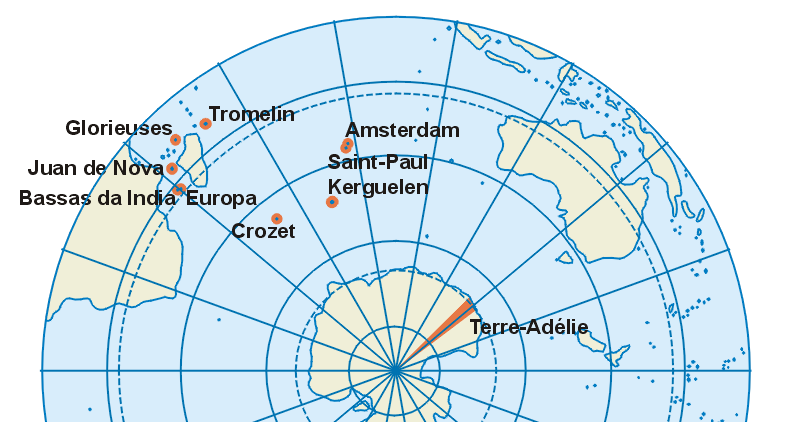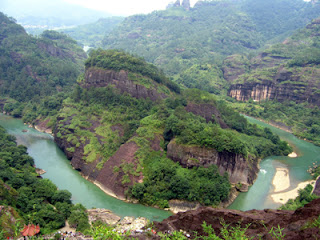| I really don't know if you're supposed to photograph a lobster belly side up. |
So after many weeks of an empty email box—well, empty except of course for all that spam—I finally took matters into my own hands. I spent hours, yes literally hours, researching recipes from the French Southern and Antarctic Lands. I think I visited every single English and French website that had any mention of Kerguelen, St. Paul and Amsterdam Islands, Crozet Islands, Adélie Land or the Scattered Islands. I also searched for Terres australes et antarctiques françaises (TAAF) all with, of course, "recettes," which is the French word for "recipes."
| Penguins on Adelie Land. Photo Credit: AntarcticBoy |
First of all let me tell you about the TAAF, known by us English-speakers as the French Southern and Antarctic Lands. It is one of the few sad remnants of the French colonial empire, which includes the aforementioned islands and a handful of temporary residents, mostly from the scientific community. The TAAF has a few meteorological and geophysical research stations, some extinct volcanoes, a small merchant marine fleet and penguins. But not really any recipes.
 |
Buns of TAAF
- 6 tbsp warm milk
- 1 tsp sugar
- 2 1/4 tsp active dry yeast
- 8 cups all-purpose flour
- 2 tsp of salt
- 2 2/3 cup sugar
- 12 whole eggs
- 2 2/3 cup butter
- 1 egg yolk mixed with 1 tbsp water
I gather from what I read, which was every single webpage currently available on the subject, that they eat a lot of lobster in the TAAF. Lobster is very available there, because it is one of the area's primary fishing resources. So with that in mind, I chose this recipe:
Lobster tails à la Plancha
For the lobster:
- 2 to 4 lobster tails
- 1/4 cup extra virgin olive oil
- Sea salt and freshly ground pepper to taste
- Lime butter
- 1/2 cup virgin olive oil
- 1/2 oz whole star anise
- 5 cloves garlic, minced
- 3 sprigs basil, chopped
- 3 sprigs lemon thyme, leaves only
- Juice of 1 lime, freshly squeezed
- Sea salt and freshly ground pepper
Next:
Leek Pie and Blue
- 2 tbsp butter
- 4 leeks, white and light green parts only
- 4 oz good quality blue cheese
- 4 eggs
- Salt and pepper to taste
- 1/2 cup cream
- 2 sheets puff pastry
- 1 egg yolk mixed with 1 tbsp water
And that was my menu. Do leek pie and lobster go together? Hmm. At this point I really didn't care.
Anyway here's how to make: First make the marinade for the lobster, since you are advised to let the tails marinate overnight. Of course I didn't, because I don't have that kind of capacity for planning.
Crush the star anise with a mortar and pestle or in a spice grinder. Mine didn't get very powdery and actually looked like it had little wood chips in it, which I didn't think would be very pleasant to eat. So I poured the lime juice and olive oil in with the anise and let it soak for about 15 minutes, then I strained it and added the other ingredients. I got plenty of flavor this way, without having to eat bark.
| Hmm, not one of my better photos. |
First dissolve the sugar in the warm milk, then add the yeast and let stand until frothy. Mix together the rest of the ingredients and add the yeast mixture. Knead until you get a nice soft dough. (Here's where I went wrong: mine was really sticky. I kept adding flour until the texture was more dough-like, since the recipe didn't say it should be sticky. I don't know, though, maybe it was supposed to be, and adding all that flour turned it into something else. Your call.)
Punch down, then divide into two equal sized pans. Let rise again until doubled in size. Brush tops with the egg wash, then bake at 350 degrees for 30 minutes or until golden.
| This was really more scone-like than bread-like. |
And the pie:
Melt the butter in a pan and saute the leeks until soft.
Line a casserole dish with a sheet of puff pastry. Spread the blue cheese on top, then add the leeks.
Naturally I did not feed lobster to my children. Because that would be stupid. So Martin and I ate this meal alone.
The lobster was yummy but probably would have been even yummier if it had, you know, marinated overnight. But I did like that anise marinade a lot, especially my non-woody version. Lobster tails, though, as they are sold at Safeway anyway are ridiculously small. I got maybe two bites out of mine and then it was over.
I liked the leek pie; Martin thought it was too doughy. I guess I could have baked the bottom half of the pie first so it would puff up more, but I didn't bother. It certainly would have improved the pie but I didn't think it was bad the way it was. Because you really can't go wrong with blue cheese, can you?
We really liked the buns of TAAF, but the way I made them they were really more like scones. They would have been nice with some strawberry jam and clotted cream. I served them as a dessert, and the kids got pieces in their lunches for a couple of days. Yum!
So that's another non-country checked off my list. Now I will sit back and hope that someone who has actually lived on the TAAF reads my blog and finds it in his/her heart to send me actual recipes from the region.
Next week: The Gambia
For printable versions of this week's recipes:










